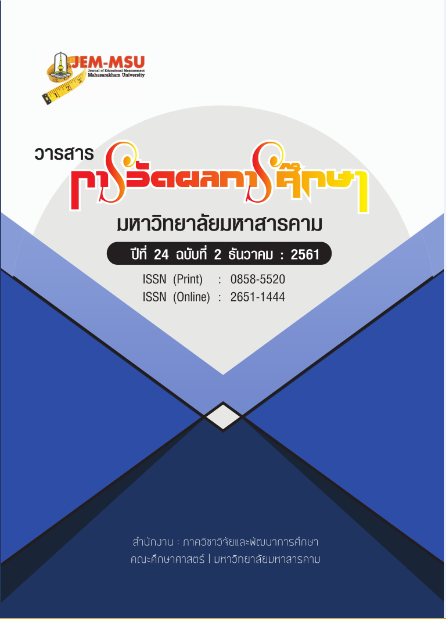The Implementation of RTI in Developing Children with Learning Disabilities at Risk in Reading and Writing Thai Words with Short Vowels for Prathomsuksa 2 Students
Main Article Content
Abstract
The purposes of this study were 1) to screen Prathomsuksa 2 students with learning disabilities at risk, 2) to develop RTI lesson plans together with a series of skill drills for reading and writing Thai words with short vowels for Prathomsuksa 2 students, based on the standardized efficiency criterion of 80/80, 3) to study the ability of reading and writing Thai words with short vowels by using the RTI lesson plans together with the series of skill drills for reading and writing Thai words with short vowels for Prathomsuksa 2 students, before and after learning, and 4) to study the learning achievements of Prathomsuksa 2 students against the 80 percent criterion. The sample comprised 12 Prathomsuksa 2 students of Bannonngamudomwit School, Bandung District, Udonthani Province, Udonthani Primary Education Service Office Area 3, obtained through the purposive sampling technique. The tools of this study were 1) KUS-SI Rating Scales: LD, 2) reading and writing Thai words with short vowels skill measure, and 3) lesson plans using RTI with a series of skill drills for reading and writing Thai words with short vowels. The statistics employed in data analysis were the mean, percentage, and standard deviation.
The findings of the study were as follows:
- The screening on learning disabilities (LD) revealed that there were 12 students, whose scores were between 61-70, and they should be given educational assistance.
- The RTI learning activities with the series of skill drills for reading and writing Thai words with short vowels for Prathomsuksa 2 students were efficient at 82.35/81.39.
- The analysis of the students’ ability in reading and writing Thai words with short vowels using the RTI learning activities with the series of skill drills for reading and writing Thai words with short vowels for Prathomsuksa 2 indicated that the posttest scores of reading and writing were significantly higher than the pretest scores. The posttest reading mean score was 61.25 percent and the posttest writing mean score was 58.51 percent.
- The learning achievement of Prathomsuksa 2 students was 81.39 percent and it could meet the 80 percent criterion.
Article Details
The content and information contained in the published article in the Journal of Educational Measurement Mahasarakham University represent the opinions and responsibilities of the authors directly. The editorial board of the journal is not necessarily in agreement with or responsible for any of the content.
The articles, data, content, images, etc. that have been published in the Journal of Educational Measurement Mahasarakham University are copyrighted by the journal. If any individual or organization wishes to reproduce or perform any actions involving the entirety or any part of the content, they must obtain written permission from the Journal of Educational Measurement Mahasarakham University.
References
กระทรวงศึกษาธิการ. (2552). ประกาศกระทรวงศึกษาธิการ เรื่อง “กำหนดประเภทและหลักเกณฑ์ของคนพิการทางการศึกษา พ.ศ. 2552”. กรุงเทพฯ: กระทรวงศึกษาธิการ.
________. (2553). ภาษาไทย สาระที่ควรรู้ คู่มือการเรียนการสอนภาษาไทย ระดับประถมศึกษา. กรุงเทพฯ: โรงพิมพ์ชุมนุมสหกรณ์การเกษตรแห่งประเทศไทย จำกัด.
________. (2553). หนังสือคู่มือการดำเนินงาน อ่านออกเขียนได้ อ่านคล่องเขียนคล่อง และสื่อสารได้. กรุงเทพฯ: โรงพิมพ์ชุมนุมสหกรณ์การเกษตรแห่งประเทศไทย จำกัด.
กุลยา ก่อสุวรรณ. (2553). การสอนเด็กที่มีความบกพร่องระดับเล็กน้อย. กรุงเทพฯ: สหมิตรพริ้นติ้ง แอนด์พับลิช ชิ่ง จำกัด.
จินตนา ช่วยพันธุ์. (2552). การเปรียบเทียบความสามารถในการอ่าน การเขียนคำภาษาไทยและความพึงพอใจในการเรียนระหว่างการสอนแบบแจกลูกสะกดคำกับการสอนเป็นคำของนักเรียนชั้น
ประถมศึกษาปีที่ 1 โรงเรียนระดมวิทยานุสรณ์ สำนักงานเขตพื้นที่การศึกษานครราชสีมา เขต 4. วิทยานิพนธ์ ค.ม. นครราชสีมา: มหาวิทยาลัยราชภัฏนครราชสีมา.
ประพิมพ์พงศ์ วัฒนะรัตน์. (2558). การช่วยเหลือเด็กที่มีปัญหาทางการเรียนรู้โดยรูปแบบ RTI, ศึกษาศาสตร์, 16(1), 1-9.
ผดุง อารยะวิญญู. (2553). อาร์ ที ไอ กระบวนการสอนในแนวใหม่. กรุงเทพฯ: ไอ.คิว.บุ๊คเซ็นเตอร์ จำกัด. พริ้มเพราวดี หันตรา. (2547). การใช้แบบฝึกพัฒนาทักษะการเขียนสรุปความจากบทร้อยแก้ว, การศึกษา ค้นคว้าอิสระ กศ.ม. มหาสารคาม: มหาวิทยาลัยมหาสารคาม.
เรวดี หงษ์สุดตา. (2553). การพัฒนาความสามารถในการอ่านและการเขียนภาษาไทย สำหรับนักเรียน
บกพร่องทางสติปัญญา ระดับเรียนได้โดยใช้ชุดฝึกทักษะการอ่านและการเขียนคำประกอบภาพที่เน้นเทคนิคการวิเคราะห์งาน, การศึกษาค้นคว้าอิสระ กศ.ม. มหาสารคาม: มหาวิทยาลัยมหาสารคาม.
สุมาลี จอดนอก. (2550). การศึกษาความสามารถในการอ่านของเด็กที่มีปัญหาทางการเรียนรู้โดยใช้วิธีการ สอนอ่านเป็นคำ ด้วยเทคนิคการใช้รูปภาพ ช่วงชั้นที่ 1 โรงเรียนบ้านดงเค็ง, วิทยานิพนธ์ ค.ม. มหาสารคาม: มหาวิทยาลัยราชภัฏนครราชสีมา.
สำนักงานคณะกรรมการวิจัยแห่งชาติ. (2551). คู่มือแบบคัดกรองนักเรียนที่มีภาวะสมาธิสั้น บกพร่อง ทางการเรียนรู้ และออทิซึม [KUS-SI Rating Scales: ADHD/LD/Auism (PDDs)]. พิมพ์ครั้งที่ 2. กรุงเทพฯ: ศูนย์วิจัยการศึกษาเพื่อเด็กที่ต้องการความช่วยเหลือพิเศษ.
อกนิษฐ์ กรไกร. (2549). การพัฒนาแผนการจัดการเรียนรู้กาพย์ยานี 11 ด้วยแบบฝึกทักษะ ชั้นประถมศึกษา ปีที่ 5 ที่เรียนด้วยกลุ่มร่วมมือแบบ Co - op Co - op และแบบเดี่ยว. วิทยานิพนธ์ กศ.ม. มหาสารคาม: มหาวิทยาลัยมหาสารคาม.
อัญชลี สารรัตนะ. (2557). การยกระดับผลสัมฤทธิ์ทางการเรียนของนักเรียนด้วยรูปแบบการตอบสนองต่อ การช่วยเหลือ (Response to interv ention, RTI), ศึกษาศาสตร์, 8(1), 1-9.
Rebecca Meléndez Chévere. (2012). RESPONSIVENESS TO INSTRUCTION: HOW EFFECTIVE IS
RTI WITH STRUGGLING MIDDLE SCHOOL STUDENTS IDENTIFIED AS AT RISK IN READING COMPREHENSION AND FLUENCY. Capella University.
Stephanie Al Otaiba, Carol M. Connor, Jessica S. Folsom, Jeanne Wanzek, Luana Greulich, Christopher Schatschneider and Richard K. Wagner. (2014).
To Wait in Tier 1 or Intervene Immediately: A Randomized Experiment Examining First-Grade Response to Intervention in Reading. Exceptional Children, 81(1),
11-27.
Taylor, R. L. (2009). Assessment of Exceptional Students: Educational and Psychological Procedures. 8th ed. USA: Pearson Education, Inc.
Vaughn,S., Linan-Thompson, S., and Hickman, P. (2003). Response to instruction as a mean of identifying students with reading/learning disabilities.
Exceptional children, 69, pp. 391-409.


